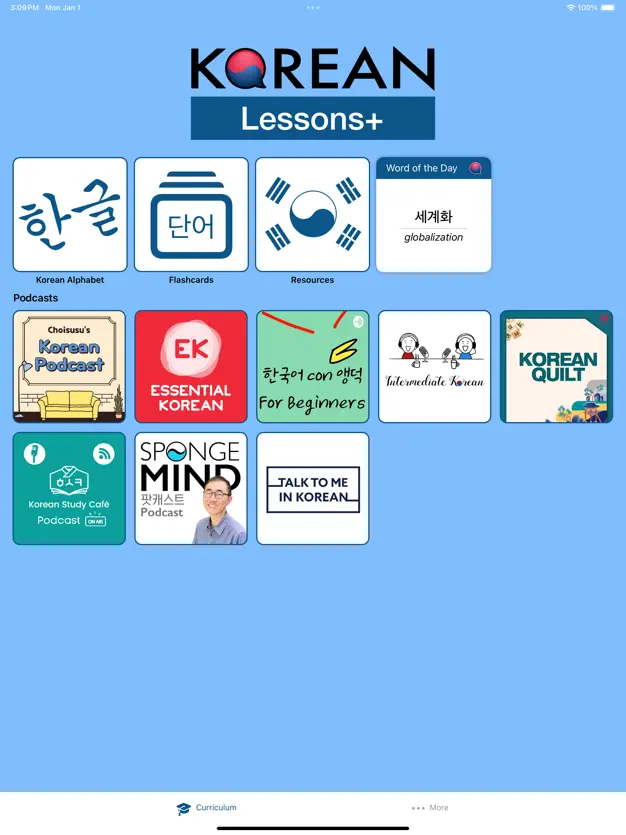Best Korean Learning Apps Recommendations
- Learn Korean & Study Hangul: Provides interactive lessons with audio and visual aids to master Hangul (the Korean alphabet) and everyday Korean vocabulary.
- Mondly: Learn Korean: Offers daily lessons with speech recognition (paired with native speakers) to improve pronunciation and conversational skills.
- Korean - Lessons+: Features comprehensive and structured lessons, podcasts of different themes, and quizzes suitable for learners of all levels, from beginners to advanced.
The popularity of Korean culture has contributed to a surge in interest in the Korean language among language enthusiasts worldwide, including in Canada. 1 While there are many ways to master a language, new learners often turn to language learning apps to kickstart their Korean learning journey. If you are looking for the best Korean learning apps recommendations, you're certainly in the right place.

📋 Criteria for Selecting the Best Korean Learning Apps
Granted that there are so many Korean learning apps in the market these days, here are five important criteria to help you make the right choice.
📱User Interface and Experience
First of all, a good learning app is all about ease and accessibility. Make sure the app has simple and clear navigation. At one glance, you should be able to tell where the settings, lessons, or quizzes are without flipping through the screens. Each screen should lead to one primary task or function where users can figure out what to do without distractions.
Intuitive and consistent design
- Clear icons, clean layout with colors and texts
- Easy to find buttons and visuals
Convenience and accessibility
- Works well on all devices: phone, tablet, computer
- Clear instructions and features
Engaging user experience
- Features daily streaks for rewards, and also seamless loading times
- Promote motivation and engagement to continue
📚 Lesson Structure and Content
Next, there must be distinctive lesson pathways and syllabi that cater to beginners, intermediates, and advanced learning levels, so that they are inclusive to everyone. Additionally, the lessons should also be varied, integrating all language learning components such as grammar, listening, writing, reading, speaking, and cultural connotations.
The lessons should balance academic learning with real-life communication, for instance, knowing how to use honorifics in formal settings and casual expressions with friends.

🗣️ Audio and Pronunciation Guides
Learners should certainly look out for an extensive native speaker's audio for every lesson component, paired with a slowed-down pronunciation speed so that learners can repeat them naturally after listening to them. Not only that, there must be phonetic and romanization support, as well as mouth or tongue visual cues for a more direct and accurate guide.
| Korean (Hangul) | Romanization | Meaning in English |
|---|---|---|
| 안녕하세요 | annyeonghaseyo | Hello (polite expression) |
| 감사합니다 | gamsahamnida | Thank you (poilte expression) |
| 잘 지냈어요? | jal jinaesseoyo? | How have you been? |
| 밥 먹었어요? | bap meogeosseoyo? | Have you eaten? |
🚀 Progress Tracking and Gamification
A good language learning app should have these features that motivate learners through tracking and rewards, such as:
Milestones achievements
- Giving consistent virtual awards or "trophies" as rewards
- Example: 5 vocabulary pairing games in a row, or having a 100-day learning streak.
Dashboard statistics
- Monitor the learner's progress in all areas, and analyze their area of strength and weakness
- Example: Needs more reinforcement for grammar and sentence structure
Daily goals reminder
- Daily gentle nudges through notifications to maintain consistency.
- Example: Spending 5 minutes or 30 minutes to revise vocabulary or complete a listening module on the app.
⬇️ Offline Accessibility
Finally, it's best to choose a language learning app with online access so that you can continue learning without an Internet connection. This would come in handy if you're constantly on the go.
Some language apps do have offline modes and advanced download features so that you can access certain audio and video tutorials whenever you want.
✨ Top Korean Learning Apps in 2025
Now, let’s explore the top three Korean learning apps in 2025. We’ll review some of their best features and provide an overview of their pros and cons to help you choose the best option for your learning experience.
🌐 Learn Korean & Study Hangul (Drops)
Pros: This app has a user-friendly interface and is effective for beginners. It is quick to navigate the interface through swipes and taps instead of depending on keyboard typing, with colorful and engaging illustrations. Additionally, it has a wide range of bite-sized games to help learners learn up to 100 words a week. 2

This app is great for anyone trying to learn a new language, it shows you the word, connect the word with an image, and repeatedly shows you the word over and over again.
norizz (user review on Apple)
Cons: The free service offers limited advanced content as it focuses mostly on vocabulary instead of grammar. Higher levels are offered at a premium subscription.
✅ Interactive 5-minute lessons
✅ Engaging audio-visual aids
✅ A strong focus on Hangul
Watch this tutorial to navigate this app seamlessly and learn Korean effectively!
🌐 Mondly: Learn Korean
Pros: This app supports adaptive learning and is suitable for various levels. It offers many practice conversations to help learners memorize core Korean words, form sentence structures to read and speak Korean phrases confidently. 3
Cons: Some advanced-level features require a subscription, and basic features can be quite repetitive once you have mastered a high learning level.
The closest thing to classroom education
Bloomberg (Google Play)
✅ Daily lessons
✅ Speech recognition
✅ Conversational practice
🌐 Korean - Lessons+
Pros: This app has diverse content and is suitable for all levels, whether it's a Korean typing keyboard to practice word composition or a wide range of Korean language podcasts (covering different topics) to improve your listening skills. There are also flashcards, a Word of the Day Widget, and printable worksheets for extra reinforcement. 4
Cons: The interface may feel outdated.

I love this app because there is so much! You can learn how to write in Korean (hangeul) and there are so many podcast episodes to teach you korean.
Amgnik 08/14/2020 (5 star reviews on Apple app store)
✅ Comprehensive lessons
✅ Podcast covering different topics
✅ Quizzes for different learning levels
Here's a comparison table to help you have an overview of these three apps, and decide which is the best according to your Korean learning goals and preferences.
| Comparison points | Learn Korean & Study Hangul (Drops) | Mondly: Learn Korean | Korean — Lessons+ |
|---|---|---|---|
| Developer / Publisher | PLANB LABS OU (Drops) | ATi Studios | InnovationApps |
| Primary Focus / Approach | Vocabulary and alphabet recognition through visuals and 5-minute mini-games | Gamified micro-lessons, conversational phrases, AR/VR, and chatbot interaction | Audio/podcast-style lessons with transcripts and offline playback |
| Strength in Speaking / Pronunciation | Moderate - listening and pronunciation exposure only | Strong - speech recognition, chatbot conversations, phrase practice | Weak - mainly listening and reading; no speech recognition |
| Offline Access | Available - download vocabulary sets for offline use | Available - download entire lesson packs for offline learning | Yes - offline playback for saved lessons and transcripts |
| Depth of Grammar / Structured Course | Low - vocabulary-centric, minimal grammar | Moderate - teaches key grammar patterns and practical phrases | Low - mostly audio-based, limited grammar focus |
| Session Style & Duration | Fixed - 5-minute bite-sized sessions designed for daily consistency | Flexible - short or long sessions, with game and AR modes | Variable - audio sessions with printable notes |
| Ideal Learner Type | Visual learners and beginners who want to build vocabulary and Hangul quickly | Beginners to intermediate learners who enjoy interactive lessons | Learners who prefer listening-based learning and audio immersion |
| Best Used As | Vocabulary booster and alphabet familiarization companion | Main language-learning app | Supplementary listening and review tool |
| Unique Advantages | Highly visual, short daily sessions, strong habit-forming design | Speech recognition, chatbot dialogue, AR/VR features | Large audio library, offline-friendly, clear pronunciation |
| Limitations / Cons | Lacks grammar, advanced structure; premium required for full access | Limited deep grammar explanations | No active speaking practice |
| Accessibility / Platforms | Available on Google Play & Apple App Store | Available on Google Play & Apple App Store | Available on Google Play & Apple App Store |
| Price Model | Freemium (premium unlocks unlimited time and offline features) | Freemium (monthly / lifetime plans) | Freemium with ads or one-time premium |

🎯 Additional Resources to Enhance Learning
Apart from language learning apps, there are also other resources to have a comprehensive Korean learning experience.
🧑💻 Online Communities and Forums
Many fellow learners often share language learning tips on online platforms like Reddit's r/Korean or Discord channels. For instance, learners will share their insights on the discussion threads of different topics like Korean fun facts, Korean grammar distinctions, Korean book recommendations, and many more.
The more you participate (asking or answering questions), the more new knowledge you'll gain!
🌏 Language Exchange Programs
Language exchange apps are engaging tools for practicing Korean with native speakers. You can communicate through message exchanges, voice notes, and even video calls. It’s a fun and interactive way to learn languages, allowing both sides to benefit by switching between languages during the conversation. Some examples of language exchange apps you can try out include Tandem and HelloTalk
📝 Supplementary Materials
It is good to approach Korean learning through different angles and resources. You can utilize a mixture of physical and digital Korean learning materials to reinforce what you have learnt through the language learning apps, like the following:
If your goal is to master proper sentence structures through reading and writing, textbooks can offer guided notes and topical questions with clear answer explanations and practical examples.
Useful to memorise new words of different themes using the spaced repetition method.
Offers a flexible learning route and also proof of participation and achievement of Korean proficiency
🧭 Tips for Effective Self-Study
No amount of learning materials can replace the determination and self-discipline that you have in self-studying, especially if you plan to master a new language like Korean from scratch. Here are four tips to kickstart your self-study sessions.
📍 Set Clear Goals
Using the S.M.A.R.T. acronym, it's best to make your Korean learning goals:
- Specific
- Measurable
- Achievable
- Relevant
- Timebound
Define what you want to achieve and by when. For example, you want to master the entire Hangul alphabet in 14 days before taking your first Korean language elective in university, and pass the Test of Proficiency in Korean (TOPIK) Level 2 within a year before applying for an exchange programme to Korea the next year.

📅 Consistent Practice
In alignment with the action of setting goals, you should also dedicate regular time slots for study. For instance, you can dedicate at least 30 minutes daily to studying Korean, whether it's through apps or learning textbooks, to build consistency and accountability.
Success doesn’t come from what you do occasionally, it comes from what you do consistently.
Marie Forleo
🎧 Immerse Yourself
Immersion and active consumption of Korean media is a great way to enhance listening and comprehension skills. Whether it's watching videos of your favourite Korean content creators, your favourite Korean dramas, or K-pop hits, this ongoing process can improve your pronunciation and speaking skills while building cultural familiarity through colloquial expressions.
🧑🏫 Seek Feedback
Last but not least, don't forget to engage with native Korean speakers near you through natural conversations or constructive feedback. You can always connect with an experienced private tutor to improve your Korean through regular one-to-one tutoring. On Superprof, you can find a Korean tutor who matches your learning goals and preferences in terms of experience, qualifications, teaching methodology, and hourly rates.
An experienced tutor can offer you immediate feedback when it comes to your writing or pronunciation to make faster progress in your language learning journey.
Have fun exploring Korean!
References
- MacDonald, J. (2023, December 11). Interest in learning Korean grows with the popularity of the Hallyu. Forbes. https://www.forbes.com/sites/joanmacdonald/2023/12/11/interest-in-learning-korean-grows-with-the-popularity-of-the-hallyu/
- App Store. (2017, April 26). Learn Korean & study hangul. https://apps.apple.com/us/app/learn-korean-study-hangul/id1227950973
- Learn Korean. Speak Korean - apps on Google Play. (n.d.). https://play.google.com/store/apps/details?id=com.atistudios.mondly.ko
- App Store. (2015, October 29). Korean - Lessons+. https://apps.apple.com/us/app/korean-lessons/id1024791122















